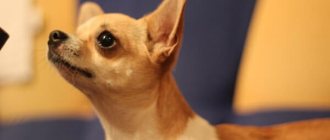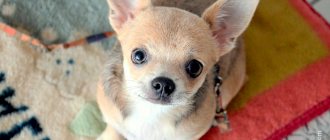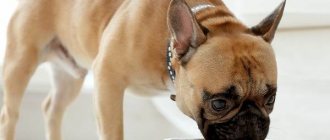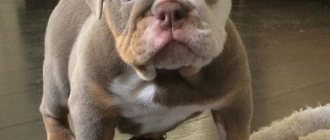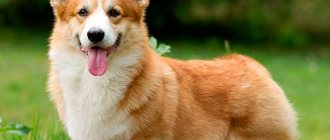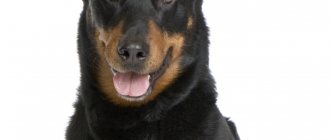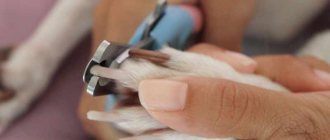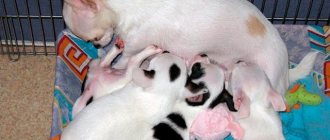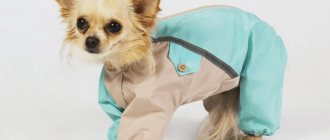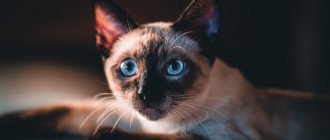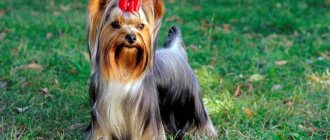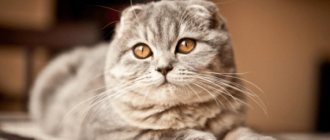The miniature dog is officially named after the Mexican state of Chihuahua, where in medieval times it was considered a sacred animal by the Indians. Opera singer Adeline Patti made a significant contribution to the popularization of the breed. In the late 19th century, the Mexican president gave her a Chihuahua hidden in a bouquet of flowers. And by the middle of the 20th century, almost every English lady acquired a Chihuahua.
The breed is one of the most popular in the world. The Chihuahua can boast of excellent upbringing and constant victories at exhibitions.
RKF breed standard with explanation
The Chihuahua standards of the Russian and International Cynological Federations do not have any fundamental differences.
The breed is classified:
- group 9 (companion dogs),
- section 6 (Chihuahueño),
- no working class
The Hichuahua is a tightly built and at the same time elegant dog, nimble, lively, a typical fidget with a hapless expression on its face.
Chihuahuas are generally absolutely fearless and have incredible reflexes.
Weight
The allowed difference is from 500 g to 3 kg. Ideal figures range from 1.5 to 1.8 kg. Individuals heavier than 3 kg will be disqualified.
Height
To evaluate dogs of this breed, the criterion is only the weight of the individual; height at the withers is not a criterion when evaluating an individual of this breed. The standard does not specify strict limits for growth.
The distance from the ground to the withers should be slightly less than the length of the body. The square format for males is the most preferred. For bitches, a more extended format is possible. According to the latest changes to the standard, the stretch index cannot exceed 110.
Head
Consists of two departments:
Cranial.
The apple-shaped skull is well rounded. A parietal fontanel is possible, but it is more advantageous when it is not there. The forehead is strongly highlighted.
The front is divided into parts.
- Muzzle, dry, compressed. When looking at it from the side, it is straight, and closer to the nose it is pointed and raised upward.
- Cheekbones, clear lines.
- The eyes are slightly convex, large and almost round, brownish or black in color. Dark iris is more preferable.
- Teeth and jaws. Skew, undershot and other deformations associated with the animal’s bite are not allowed. A straight or scissor jaw position is considered normal.
- The ears are somewhat reminiscent of a cat's. They do not hang, the auricle is open. Ideally, they form an almost isosceles triangle. When at rest, they are slightly lowered towards the temples, forming an angle of 45 degrees.
To read: Everything you need to know about childbirth and pregnancy in a British cat
The lack of a row of teeth is considered a flaw, but not critical. They will not be disqualified because of it.
Frame
The breed standard specifies the ideal properties and proportions of each part of the body.
The neck is not short, with tight-fitting skin. The scruff is slightly pronounced. For long-haired Chihuahuas, a lush “mane” is a must. The thickness of the neck may vary depending on the sex of the individual. Body:
- Top line and withers. The back is parallel to the floor with a slight elevation at the withers.
- The back is not wide, but quite dense.
- The lower back, the muscles are clearly defined.
- The croup is wider than that of many representatives of miniature breeds. Both flat and slightly inclined are allowed.
- The chest, the rib cage is quite wide, round in shape. Gives the impression of being massive. Barrel-shaped breasts are not acceptable.
- The bottom line, the toned shape is emphasized by clear lines.
- The tail is set high. Smooth, pointed towards the end. Pointed upward with a slight curve. Length equal to half the length of the back. The coat corresponds to the body. Long-haired Chihuahuas have a longer tail that is usually curled and resembles a headdress.
Limbs
The forelegs, when positioned correctly, are straight and level, regardless of the angle. Can't be called short. The shoulders have visible muscles. The breed is always distinguished by the distinct angles of the shoulder blades and forearms. Elbows fit tightly to the body. The paws are not large. The standard does not recognize the similarity of paws to those of a cat or a hare. The fingers should be well apart. The nails are quite convex.
The hind legs have strong muscles and pronounced angles of the hip, knee and hock joints. The hock joint is equal in length to the elbow joint. The Achilles tendon is well developed. When viewed from the rear, the paws are well apart.
Movements
The Chihuahua walks like a leader. The steps are wide and the lunge is strong, with a powerful push. The gait is free and slightly springy. The hind legs follow exactly behind the front legs. The head is raised and looks strictly in the direction of movement. The back is straight and strong.
The leading distinctive feature of a purebred individual is the habit of holding its tail. When moving, the Chihuahua keeps it pointed upward or bent in a semicircle.
Coat
The skin is delicate, thin and elastic in any area of the body.
Chihuahuas have several coat variations:
- Smooth-haired. The hair is short and lies close to the body. Rarely are individuals born with undercoat, in which case the length of the coat is slightly longer. A mandatory rule is the softness and shine of the wool. Hairless dogs are disqualified.
- Long-haired. The hair is longer and the coat is silkier. Slightly wavy, but better smooth. The fur is long in the area of the ears, on the back near the withers, on the hind legs (forming panties) and on the tail. Individuals with excessively long or curly hair are not allowed.
To read: Elegant and willful dog Toy Terrier: characteristics of the breed and weight of the puppy
Long-haired Chihuahuas cannot have short-haired puppies, but smooth-haired ones can have both.
Color
There are many varieties of Chihuahua colors. There are no restrictions in the standard for both smooth-haired and long-haired dogs.
The breed has about 70 types of colors. But there are only a few of the most common:
- Red (Red): completely red or red with white markings,
- Golden fawn: looks like a less rich red or cream,
- Black and Tan: The base tone is black, but fades to a lighter tone on the limbs or other parts of the dog's body.
- Spotted: Most often medium-sized spots on a white coat.
The following colors are less common and are considered uncharacteristic for this breed:
- white,
- black,
- chocolate,
- brindle,
- blue.
<,>,
What affects a puppy's growth?
The height and weight of a Chihuahua puppy are influenced by both hereditary factors, living conditions and health status. How active a pet’s lifestyle is can also affect what size it will reach.
The main factors that influence the development of a puppy:
- genetics. For representatives of this breed, it is heredity that determines to what age the puppy will grow. Chihuahuas of some lines grow faster, others - slower. In addition, heredity also influences when the Chihuahua bitch begins her first heat, after which she will grow, if at all, only a little;
- quality of cultivation. The fashion for mini dogs has created a trend towards weight loss in Chihuahua puppies. This, in turn, has led to the fact that some dishonest breeders, who would be more correctly called breeders, deliberately underfeed the babies of this breed so that they do not grow and remain miniature by the time of sale. Considering that Chihuahuas move to their new owners quite late - after three or even four months, it is not difficult to guess what consequences such rearing can lead to. As a result of underfeeding, puppies actually grow poorly and do not gain weight, but in addition to this, they can also get vitamin deficiency, allergies, severely weakened immunity, metabolic disorders, as well as chronic diseases of various systems and organs;
- diseases. After most serious illnesses, the dog's growth slows down or even stops altogether;
- feeding . Chihuahuas must receive complete, high-quality food, but it must be taken into account that these dogs are prone to overeating and weight gain. Therefore, it is very important to measure your pet’s serving size exactly, down to the gram. And in order for him to be healthy and grow well, you need to feed your Chihuahua either ready-made premium food, or better yet, super-premium or holistic food. If the dog eats natural foods, then it needs to receive a lot of protein foods, as well as foods containing calcium;
- activity. If a Chihuahua moves enough, it trains its muscles and develops physically. At the same time, excess weight that the pet may have gained is lost. Also, puppies that willingly run and play grow faster in height.
The weight of a Chihuahua also depends on how much it weighed at birth.
A pet that weighs between 70 and 80 grams at birth will grow up to be very small—mini or even micro. A puppy weighing 80-120 grams at birth will be a small standard. And medium and large Chihuahuas weigh 120-145 and 145-170 grams at birth.
NOTE!
The weight of a Chihuahua also depends on the size of the litter. So, if a bitch gave birth to 1-3 babies, then among them there may be both large and medium-sized dogs. And if 4 or more puppies were born, then in this case they will be either mini or small standards.
Weight table by month
The most reliable and accurate forecast of how much a pet should weigh can be given by its pedigree. Size, like some other parameters, is inherited. But to determine the approximate weight, you can use the weight table for Chihuahuas.
| Age/Weight of the newborn, gr. | 70 | 80 | 85 | 100 | 110 | 120 | 130 | 145 | 155 |
| 1 Week | 106 | 113 | 142 | 156 | 184 | 198 | 227 | 255 | 269 |
| 4 weeks (1 month) | 198 | 227 | 269 | 312 | 369 | 452 | 482 | 539 | 595 |
| 8 weeks (2 months) | 312 | 369 | 454 | 539 | 610 | 680 | 765 | 822 | 936 |
| 12 weeks (3 months) | 425 | 539 | 624 | 737 | 851 | 936 | 1049 | 1162 | 1276 |
| 16 weeks (4 months) | 567 | 709 | 851 | 964 | 1106 | 1247 | 1389 | 1531 | 1673 |
| 20 weeks (5 months) | 680 | 851 | 992 | 1162 | 1304 | 1474 | 1644 | 1814 | 1985 |
| 25 weeks (6 months) | 765 | 946 | 1134 | 1332 | 1503 | 1701 | 1899 | 2070 | 2269 |
| 18 months | 908 | 1135 | 1362 | 1589 | 1816 | 2043 | 2270 | 2497 | 2724 |
To read: Varieties of colors of cats of the Thai breed
Estimated weight by one and a half years at a weight of 2 months:
| Weight at 2 months | Final weight of an adult dog |
| 0.30 kg | 0.90 kg |
| 0.36 kg | 1.15 kg |
| 0.45 kg | 1.35 kg |
| 0.55 kg | 1.60 kg |
| 0.60 kg | 1.80 kg |
| 0.70 kg | 2.05 kg |
| 0.76 kg | 2.25 kg |
| 0.93 kg | 2.71 kg |
| 1.10 kg | 3.18 kg |
Muzzle and its dimensions
The shape of a Chihuahua's head should resemble an apple; if it is not proportional and narrowed or flattened, this is a deviation from the standard. The ears are erect or slightly tilted forward, but not curled; if the dog's ears are half bent, they are too soft - this also disqualifies the breed.
The dog's skull is widened at the base and gradually narrows towards the nose. The nose is not always black, but dark-eyed dogs have a dark nose, and the lighter the eyes, the lighter the nose. And some more features of the proportions of the muzzle:
- The ears are set quite wide - the base of the ears is wide, directed upward and to the sides, the tips are slightly rounded;
- The nose is slightly turned up.
- The lips are hardly noticeable, they are dry, like the dog’s cheeks;
- The eyes are large, but not bulging, with a pleading expression;
- Long-haired dogs have longer hair on the head and ears and shorter hair on the face.
The Chihuahua subspecies described below also have a short, fox-like muzzle and, conversely, a very voluminous head with a clearly visible stop (the transition from the nose to the forehead). These are all deviations from the standard. But a pet with such qualities can also be absolutely healthy and live happily in a family where they adore him.
Limbs
The forelimbs are vertical, parallel to each other, symmetrical. The shoulders are moderately muscular and level. The angles of the glenohumeral joints have a well-defined outline. Forearms are straight, optimal length. Pasterns strong, flexible, slightly sloping.
The Chihuahua's hind limbs are muscular, symmetrical, located parallel and vertical relative to each other, and are in perfect harmony with the forelimbs in movement. The hock (tarsal) joints are short, with well-developed Achilles tendons. The hocks are vertical, straight, and widely spaced.
The paws (feet) are small and oval in shape. The fingers are widely spaced, but not splayed. Dewclaws (fifths) are not welcome. Claws of optimal medium length, well curved. The paw pads are elastic, soft and developed.
What rules to follow when choosing
Important nuances when choosing dog clothes:
- Determine the size of the pet: body features, volume of fur. So, you can find special clothes for a mini Chihuahua or puppy.
- The suit should be comfortable, so the option with a reserve or for growth will not work. The product should be easy to take off and put on.
- Consider gender: for males and females, clothing may differ not only in colors or decorations, but also in functionality.
- Assess the level of fabric and quality of seams.
- Avoid zippers on clothing that could pinch the animal's skin or fur. It is better to prefer Velcro, buttons, snaps.
Advice! The thing must correspond to the goals. For example, if you buy clothes for the winter, they should have trouser legs, a warm collar or a hood.
Characteristics
The dogs have a confident gait, with a wide stride and a strong lunge. Pets push off the ground powerfully. The dog's head is always raised and looks in the direction the movement is directed. The Chihuahua walks confidently, freely, and elegantly.
Dogs quickly adapt to changing conditions, are undemanding in everyday life and are able to ignore minor inconveniences. Pets are psychologically stable, especially when compared with other miniature dogs.
This is interesting: 4 less popular decorative breeds
Story
The Chihuahua is the national pride of Mexico, because this is where this breed comes from. Since about 1850, there has been information that indigenous people are selling small dogs with unusual appearance to tourists.
The animal was presented to the general public in 1904 at an exhibition in the USA (Philadelphia). Almost 20 years later, Chihuahua clubs began to appear. The first one opened in 1923 in America, at which time breed standards were adopted (but so far only for smooth-haired individuals).
The British Chihuahua Club adopted new standards in 1949, and the Chihuahua breed was divided into two subspecies: long-haired and short-haired.
The origin of the Chihuahua dog is shrouded in legends. Mexican aborigines believe that the ancestors of their pets resembled monkeys because they knew how to climb trees. Ancient Indian civilizations (Aztecs, Mayans) retained memories of a tiny dog called techichi.
During excavations, archaeologists continue to discover the remains of Chihuahuas. The oldest finds date back to 1.5 thousand years BC. e., these are the burial places of the Toltec tribe (it was customary for dogs to be placed in the tomb along with their deceased owners). They got Chihuahuas from an even more ancient and mysterious civilization - the Incas.
XVI-XVIII centuries AD e. almost turned out to be fatal for the Chihuahua breed - the conquistadors from Spain (and their descendants) mercilessly exterminated the Indians along with their pets. But dog enthusiasts at the beginning of the 19th century were able to find several purebred dogs in one of the surviving Aztec settlements.
Animals began to spread across Europe not so long ago - in the 1950s, when the breed had already gained official recognition and standards. In the USSR, the first pair of Chihuahuas appeared in 1959, when the dogs were brought from Cuba as a gift to N.S. Khrushchev.
Disqualifying faults
The defects listed below indicate a serious deviation from the breed standards and prohibit a disqualified dog from participating in breeding and breed exhibitions. The reason for disqualification may be either unusual behavior or deviations in appearance.
List of disqualifying defects designated by FCI and RKF:
- behavioral deviations accompanied by uncontrolled aggression without obvious reasons, excessive fearfulness and shyness;
- pronounced defects in the physical and mental development of the animal;
- unilateral or bilateral cryptorchidism in males;
- dogs of atypical structure (for example, “Deer type”), mixed breeds;
- extremely long body;
- new in 2010, the International and Russian Cynological Federation imposed a ban on an open fontanel in a dog, a breed trait previously recognized as a standard;
- cropped, short or not erect (after 6 months) ears;
- docked (short) tail;
- severe disorders of the dental system, jaw deformation;
- non-standard coat type, baldness (alopecia), albinism;
- merle color (merle);
- not corresponding to the weight category from 500 grams to 3 kg.
The examination for compliance with the standard is carried out no more than 3 times, with a break of at least 3 months. The test data is entered by an authorized expert into the RKF database, and a duplicate mark is entered into the dog’s pedigree.
Flaws
Any deviation from the standard parameters is considered a serious deficiency. These include the following points:
- narrow skull;
- flat skull;
- small eye size;
- large protrusion of the eyes;
- long muzzle length;
- pointed ears;
- completely drooping ears;
- small neck;
- curved or concave spine;
- strongly sloping croup;
- long body length;
- barrel-shaped ribs;
- narrow set of front paws;
- elbows extending far away from the body;
- short or crooked legs;
- small breasts;
- displacement of the cup in the knees;
- jaw displacement;
- a short or completely curled ponytail with an incorrect fit;
- completely thin hairline;
- extra teeth;
- unexpressed stop.
How to get used to wearing
At first, the animal may react negatively to such an innovation as wearing clothes. Therefore, it is not recommended to wear the item immediately after purchase, as the dog needs to get used to it. Otherwise, your pet may become stressed and feel worse. Let the purchase lie in a visible place so that the pet can approach it, examine it and get used to the foreign smell.
The first fitting should not be long - a few minutes is enough. At this time, you can talk to the dog affectionately, pet it, or distract it with games. And after getting acquainted with the item, you should definitely praise the pet and feed it, thereby reinforcing the positive experience.
Important! You should be patient, as it will most likely take time to accustom your Chihuahua to accessories. If the pet breaks out, you cannot force it, it means that at the moment it is not ready to learn.
Do you need clothes?
The main reasons for purchasing clothes for animals are: aesthetics, beauty and protection of the body from the negative influence of the environment.
For small and heat-loving breeds, overalls and insulated clothing options are most relevant. Raincoats are also often purchased to protect from wind, moisture and dirt. So that the animal does not catch a cold and can safely walk outside even in cold weather, there are special dog shoes. Attention! Clothes for Chihuahua puppies are available in a smaller range, but kids need them. Puppies are more sensitive to temperature and with a slight cold snap or draft they can get sick.
Coat
There are two types of Chihuahua fur:
- short;
- long.
The short-haired coat fits tightly to the dog's body and has smooth and soft hairs of a straight structure. If there is undercoat, the length of his hair will be slightly longer, as well as on the neck and tail. On the head and ears the hair is the shortest, in the throat area it is practically absent.
The long-haired coat has thin and soft hairs of an even structure. Light waves are allowed, but not curly hair. Longer hair is found in the following places: ears, neck, paws, tail, chest. The dog's body should not be covered with too long and thick hair.
Does a dog need shoes?
Pet product manufacturers can't come up with anything to please animals and their owners. Another life hack is shoes for dogs, which are worn in accordance with the season and the weather outside.
Despite the fact that some people think that doggy boots are an excess and a glamorous entertainment for spoiled owners, the shoes perform an important task:
- protection of pads from cuts, prevention of corns;
- preventing contact of delicate skin with aggressive reagents that are sprinkled on sidewalks and paths in winter;
In addition, it provides reliable protection for the paws from dirt and moisture. It’s enough to put on warm socks for your dog, choose shoes that fit, and you can forget about washing your paws for a long time, and your dog’s legs will be warm.
In our online store you can purchase fashionable clothes and shoes for any weather for your pet:
note
Quick view
Tuzik Overalls Spitz sports warm female assorted (1 piece)
1 PC
2 470 ₽
2 100 ₽
Show all offers
Quick view
Tuzik demi-season blanket for dogs 60 cm No. 7 assorted (1 piece)
1 PC
1 999 ₽
1 699 ₽
Show all offers
Quick view
FOR MY DOGS knitted dog jacket Snowflake pink FW655-2018 (10-12)
10-12 8-10
10-12
1 586 ₽
1 507 ₽
Show all offers
Quick view
FOR MY DOGS boots for dogs winter black FMD658-2020 BL (0)
0
to order
Show all offers
Quick view
FOR MY DOGS winter boots for dogs black/pink FMD663-2020 BL/P (0)
0
to order
Show all offers
Quick view
FOR MY DOGS sweater for dogs Bullfinches blue FW829-2019 (12-14)
12-14 16-18 18-20 8-10
12-14
to order
Show all offers
